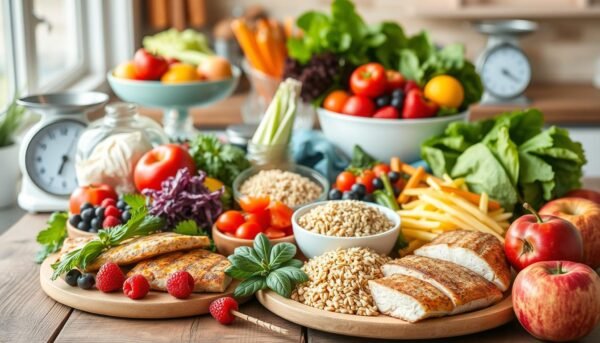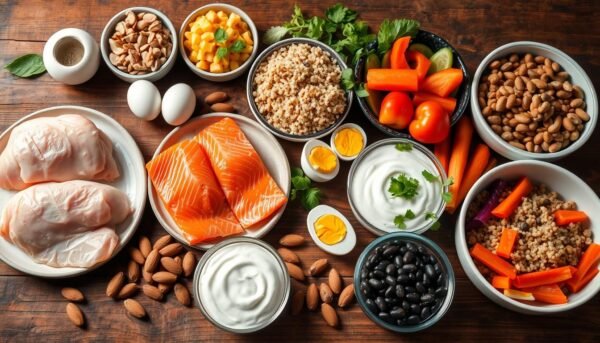Looking in the mirror, I felt frustrated and surprised. The extra weight seemed to grow on its own. But then, I found the 90-30-50 diet plan. It promised to help me lose weight.
Struggling to lose 50 pounds or more? I’m here to say it’s possible. The 90-30-50 method, made by dietitian Courtney Kassis, RD, is a hit. Kassis lost 15 pounds in two months and has helped many others.
In this guide, we’ll explore the 90-30-50 diet’s science. We’ll talk about realistic weight loss goals and how to lose fat for good. Let’s start a journey to better health and weight loss together.
Understanding Safe and Sustainable Weight Loss Goals

Losing weight is a journey. It’s important to have a realistic and sustainable mindset. The Centers for Disease Control and Prevention (CDC) say to lose 1-2 pounds a week. This means losing 50 pounds could take 7 months to 1 year.
Setting Realistic Weekly Weight Loss Targets
Weight loss rates vary due to genetics, sex, and age. Heavier people might lose weight faster at first. But, weight loss isn’t always steady. In 30 days, a good goal is to lose 8-16 pounds, based on your own factors.
Factors Affecting Weight Loss Speed
- Genetics and metabolism
- Sex and age
- Initial body weight and composition
- Physical activity levels
- Nutritional intake and calorie balance
- Stress and sleep quality
The Science Behind Sustainable Fat Loss
Successful fat loss comes from a few key things. These include a calorie-controlled diet, regular exercise, enough protein, and healthy fats and fiber. By eating right and exercising, you can lose weight for good.
Slow and steady is the best way to lose weight healthily. With the right plan and mindset, you can reach your goals and feel better overall.
The 90-30-50 Method: A Balanced Approach to Weight Loss

Losing weight is hard, but the 90-30-50 method makes it easier. It’s all about eating 90 grams of protein, 30 grams of fiber, and 50 grams of healthy fats every day.
It was made by Courtney Kassis, who lost 15 pounds in two months. She also got better from Hashimoto’s disease. This method keeps your metabolism high, reduces cravings, and boosts metabolic health.
Foods that fit well into this method include:
- Lean proteins like chicken, beef, and eggs
- Fiber-rich greens such as spinach, kale, and broccoli
- Healthy fats from avocados, nuts, seeds, and olive oil
Eating the right amounts of these nutrients can change your weight loss journey. Foods high in monounsaturated fats help your body use insulin better. This means your cells can handle blood sugar better.
Protein makes you feel full and helps you lose fat while keeping muscle. Fiber is key for good digestion, regular bowel movements, and controlling blood sugar. All these help you manage your weight better.
If you’re having trouble with weight, metabolism, or chronic conditions, the 90-30-50 method is a good choice. It’s balanced and can improve your health and help you lose weight.
| Nutrient | Recommended Daily Amount | Benefits |
|---|---|---|
| Protein | 90 grams | Increases satiety, reduces hunger, supports muscle tone |
| Fiber | 30 grams | Promotes digestive health, regulates blood sugar, contributes to feelings of fullness |
| Healthy Fats | 50 grams | Aids in weight loss by reducing the likelihood of overeating, supports hormone production essential for metabolism and weight management |
How to lose 50 pounds Through Strategic Meal Planning

Losing 50 pounds needs a smart meal plan. You must eat less and exercise more. This way, you can lose weight safely and keep it off.
Creating a Caloric Deficit That Works
To lose weight, you need to burn more calories than you eat. Try to eat 500-1,000 calories less each day. This can help you lose 1-2 pounds a week.
Eat more fruits and vegetables. They are low in calories but full of fiber and vitamins.
Balancing Macronutrients for Optimal Results
Your diet should have the right mix of protein, carbohydrates, and healthy fats. This keeps you full and gives you energy. It also helps keep your muscles strong while you lose weight.
Get a meal plan from a dietitian or nutritionist. They can make a plan that fits your needs and likes.
Meal Timing and Portion Control Strategies
- Use portion control and eat mindfully. Eat smaller meals and listen to when you’re full.
- Try intermittent fasting like the 16:8 diet. It can help you lose weight by eating less.
- Drink lots of water every day. Aim for more than two liters.
Losing 50 pounds is a slow and steady process. Stick to your meal plan and exercise regularly. This is the best way to reach your goal.
| Losing Weight Food Ideas | Losing Weight Grocery List |
|---|---|
|
|
Essential Protein Requirements for Maximum Fat Loss

Getting rid of fat is linked to eating enough protein. Studies show that eating 25% to 30% of your calories as protein helps with weight loss. This is more than the 0.8 grams per kilogram for healthy adults.
If you want to lose 200 lbs or lose 50 pounds in 3 months, you need to get enough protein. Healthy adults should eat 10% to 35% of their calories as protein. The higher amount is better for losing weight.
- Sedentary people need at least 0.8 grams of protein per kilogram of body weight. Active people might need 1.2 to 2.0 grams per kilogram.
- A 150-pound person should eat 54 grams (RDA) to 135 grams (upper end) of protein daily.
- Eating protein-rich foods like lean meats, fish, eggs, dairy, beans, and legumes helps meet your protein needs.
Eating protein at every meal and snack is a good way to get enough. It helps keep your muscles while burning fat. This leads to lasting weight loss success.
The Role of Healthy Fats and Fiber in Weight Management
Many people focus on eating less and exercising more to lose weight. But, healthy fats and fiber are also important. The 90-30-50 diet suggests eating 30 grams of fiber and 50 grams of healthy fats each day. This can help you lose weight in a healthy way.
Understanding Anti-inflammatory Fats
Not all fats are good for you. Healthy fats, like those in almonds, olives, and avocados, are anti-inflammatory. They also support heart health and make you feel full. This can help you lose weight in 8 weeks or a 30-day diet plan.
High-Fiber Foods for Sustained Energy
- Chia seeds (10g of fiber per 3 tbsp)
- Black beans (8.3g of fiber per cup)
- Chickpeas (8.1g of fiber per cup)
- Lentils (7.8g of fiber per cup)
Eating foods high in fiber can keep you full and energized. It helps you avoid snacking too much. Start by adding a little more fiber to your meals each day to avoid stomach problems.
Daily Nutrient Targets and Tracking
The Dietary Guidelines for Americans 2020-2025 say 20-35% of your calories should be from fat. Choose healthy fats over saturated ones. Women should eat at least 25 grams of fiber daily, and men should aim for 38 grams. Tracking your nutrients helps you reach your weight loss goals.
Eating healthy fats and fiber can help you lose weight in a good way. A diet and exercise plan together is the best way to keep weight off for good.
Exercise Strategies to Accelerate Your Weight Loss Journey
The 90-30-50 diet is great for nutrition, but exercise is key for losing weight and staying healthy. Mix cardio and strength training to burn calories and build muscle. Health experts say to do at least 150 minutes of moderate activity like brisk walking each week.
Do strength training exercises two times a week to keep and grow muscle. This boosts your metabolism and helps with weight control. Try activities like Pilates or yoga to sculpt your body and burn calories even after you’re done.
Find exercises you like and can do often. This is important for losing weight in your 40s. With the right diet and exercise, you’ll reach your weight loss goals.
This post may contain affiliate links which means I may receive a commission for purchases made through links. I will only recommend products that I have personally used! Learn more on my Private Policy page.